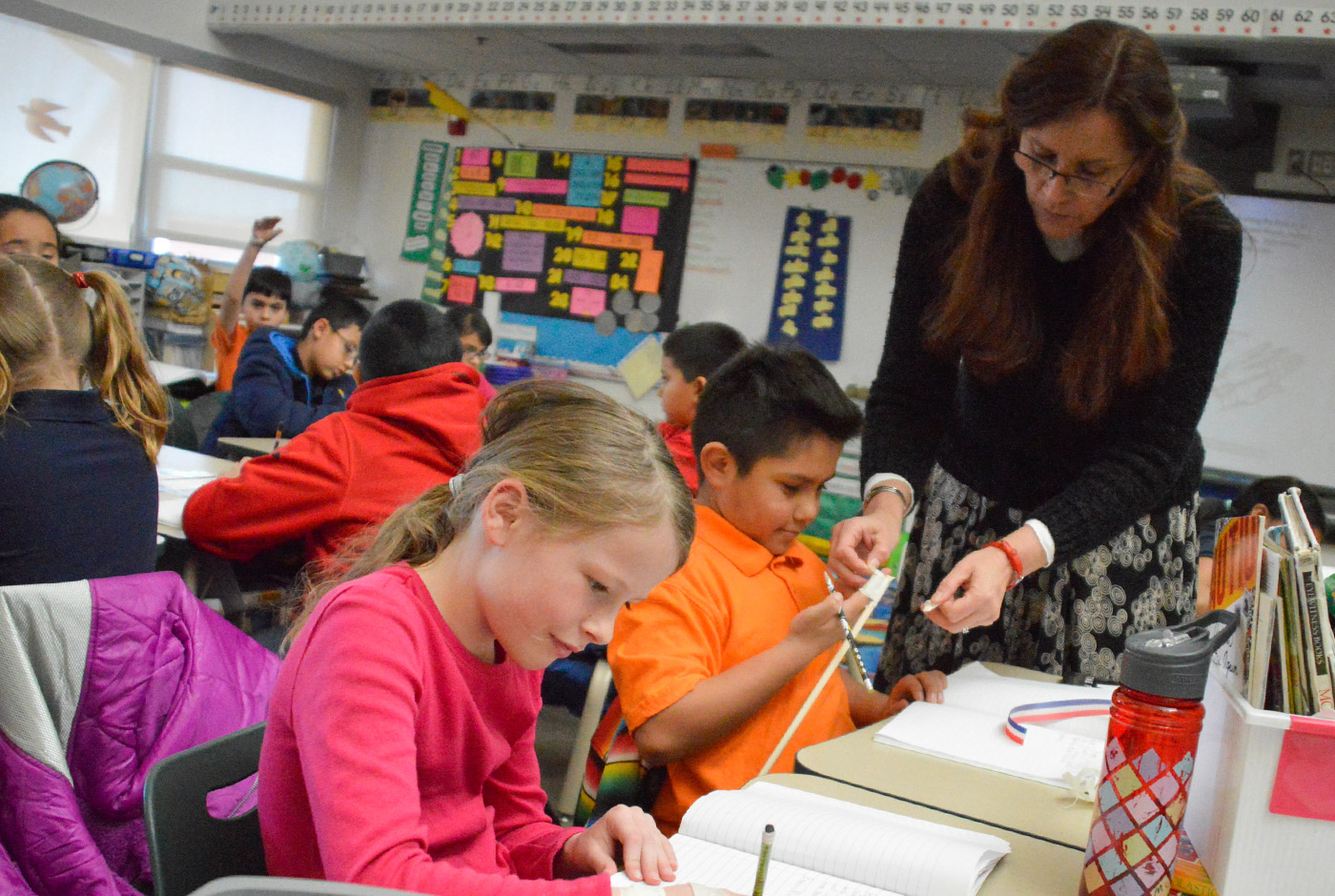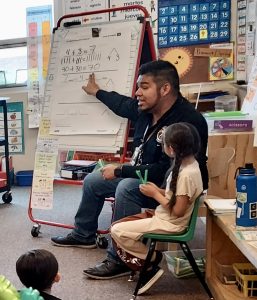Learning by Discovery and Struggle:
Brenda Dominguez, Golden Apple Award Winner & Exceptional ISEC Teacher
Step into the classroom of Brenda Dominguez, third-grade teacher at Amy Biehl Community School in Santa Fe, and you immediately experience an example of excellence in education. It’s easy to see why she is one of seven New Mexico elementary school teachers to receive a 2016 Golden Apple Award for Excellence in Teaching. The award recognizes inspirational teachers whose quality of instruction and commitment to the profession directly determine students’ academic success and encourage positive change in New Mexico classrooms.
After 17 years of teaching, Brenda has especially enjoyed her last six years at Amy Biehl, where the focus is on science and sustainability. She connects her effectiveness with her involvement with ISEC since its start in 2010 and has seen a shift in her teaching through the inquiry learning process, curriculum, and professional development that the program offers.
“When I first took the ISEC kit trainings, I learned so much about the value of allowing students to struggle and explore,” she reflected. “Knowing that teachers should act as facilitators, while providing scaffolding, opened my eyes to a different type of teaching.”
Brenda demonstrates her effectiveness during a Human Body lesson. This life science module has been put out of circulation since ISEC changed to focus on physical and Earth science, but Brenda borrowed it from another school to ensure that her class was exposed to the curriculum, which is aligned with NM Science Standards.
Students investigate several activities with restricted movement for a deeper understanding of the function of bones and joints
She first engages her students by inviting them to imagine being blobs without bones. She asks them to draw upon their prior knowledge of the skeletal system and function of bones, wiggles her fingers and asks, “What is the difference between phalanges in our hand and the femur in our leg? Talk to your neighbor.”
After a brief uproar of excitement, the class is refocused in a discussion about the size difference of bones and how they function in different ways for support, protection, and movement of the body.
Brenda introduces the focus question, “How do our bones work together to accomplish a task?” Then she asks the class for their best guess at a possible hypothesis. “I want you to challenge yourself and struggle,” she says. Each student who answers, calls upon the next student to share an additional thought, with her reminder to use their vocabulary in complete sentences and the “most important word in third grade, ‘because’….”
Then the investigation takes a deeper look at the function of joints. Some students’ thumb joints are taped around a popsicle stick, while others’ have their wrist, index and middle fingers taped to a longer dowel. With the imposed restrictions, small groups rotate through activities such as writing, stacking pennies, cutting a circle with scissors, pouring corn cornels into a container, and linking paper clips.
Kids find science engaging for so many reasons. If they are allowed to conduct an exploration without too much frontloading, they enter a world of discovery and amazement…the connections are exciting and long-lasting.
Afterward, the students talk in their groups about which activities were the most difficult and why. Together the class discusses and agrees that thumbs are essential for performing everyday tasks easily.
“Smaller bones and joints allow us to do smaller things,” says one student. “How do you know,” asks Brenda, “and what is your evidence? Talk to your science notebook.”
Students document observations in their notebooks, such as, “If you can’t move your joints, you can’t do much.” And “Moving joints makes it easier to cut paper and write, because they work with bones in a system.”
Brenda uses these skills of harnessing the power of inquiry learning on a daily basis to cement her students’ deep understanding of the content. “Kids find science engaging for so many reasons. If they are allowed to conduct an exploration without too much frontloading, they enter a world of discovery and amazement…the connections are exciting and long-lasting.”
The hands-on or inquiry aspect of ISEC allows students to become active participants in their learning process, which often leads to a quest for further exploration and understanding. Brenda also knows the value of encouraging the students to work together to determine meaning and make connections after the investigation, in addition to creating opportunities for concept and vocabulary exploration during each science lessons.
She makes learning fun and challenges the kids at the same time. “What I like best about Ms. Dominguez is that she teaches really well,” said one eager girl at the end of class. “She gets us ready for harder things to learn because she makes us struggle.”
Joint mobility limitations are introduced before the exploration begins
Brenda says she is honored and humbled to receive the prestigious Golden Apple Award after being chosen from a pool of 215 nominees. Each was required to complete a detailed application describing their teaching philosophy and methodology, professional development, volunteer work, and lessons learned during their career. Finalists are observed in the classroom and interviewed by a selection committee. Principals, colleagues, parents, and students also provide input.
The award includes a cash stipend and additional money for professional development. Recipients become part of the Golden Apple Academy of Fellows, a professional community of outstanding teachers given further opportunities to advance teaching and learning. Fellows also serve on the selection committee to determine future winners.
In addition to her hard work and recognition, Brenda takes time to acknowledge the work of all teachers. “I know how challenging the profession can be. We give so much of ourselves, on every level, and often don’t have many opportunities to be celebrated. We are all surrounded by a multitude of teachers who are deserving of recognition, and I look forward to the day when more teachers can be celebrated!”
The LANL Foundation and ISEC team congratulate Brenda Dominguez on her award and thank all teachers for their hard work and dedication.
Main Photo Caption: Brenda Dominguez introduces her third grade class to an inquiry lesson about the function of bones and joints using the Human Body curriculum module.



